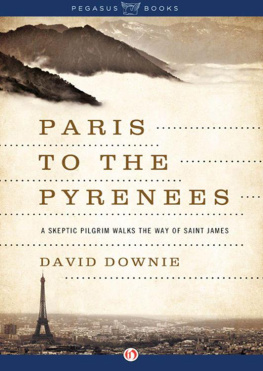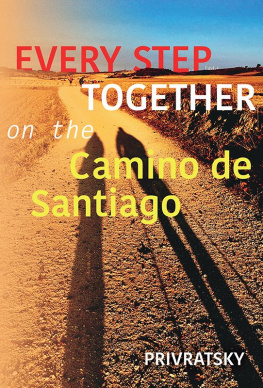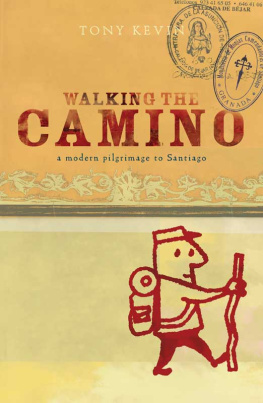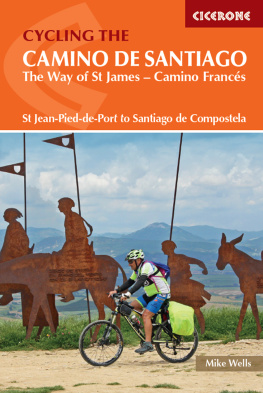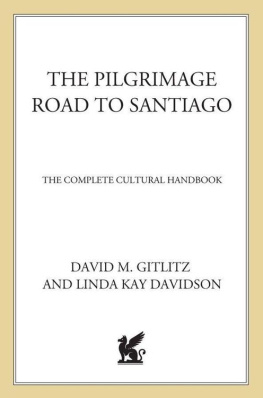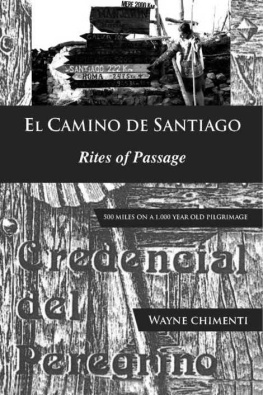PARIS
TO THE
PYRENEES
A SKEPTIC PILGRIM WALKS THE WAY OF SAINT JAMES
DAVID DOWNIE
PHOTOGRAPHS BY ALISON HARRIS

PEGASUS CRIME
NEW YORK LONDON
CONTENTS


For Alison:
Another one from the heart.
ACKNOWLEDGMENTS AND THANKS

Special thanks go to our friend and colleague G. Y. Dryansky for his strategic assistance, to our wonderful agent Alice Martell, and to my inquisitive editor Jessica Case and distinguished publisher Claiborne Hancock, for their enthusiasm and generosity.
A warm merci to our many friends who cheered us on, and the countless helpful and inspiring people we met before leaving or encountered on the road, including Joel Avirom and Jason Snyder, Michael Balter, Steven Barclay and Garth Bixler, Jane Beirn, Martine Bouchet, Huub Broxterman, Franoise Cabanne, Kimberley Cameron and David Brody, Henri Clerc, Jacques Clouteau, Bertrand Devillard, Robert and Solange Ducreux, Marie-Pierre Emery, Mark Eversman, Eva Fage, John Flinn, Frre Jean-Rgis of Sainte-Foy Abbey, Sandra Gilbert, Anton Gill, Karine Gribenski, the late Canon Denis Grivot of Autun Cathedral, Jean-Claude Jacquinot, Dominique Jacquot, Jean Kahn, Barrie Kerper, Peter Jan Leeman and Aad van der Krogt, Margaret Mahan, David Malone, Sarah McNally of McNally-Jackson books, Mia Monasterli, Ghislain Moureaux, Anthony Oldcorn, Elaine and Bill Petrocelli at Book Passage, the late Polly Platt, Priscilla Pointer and the late Bob Symonds, Georges and Bernie Risoud, Harriet Welty Rochefort, Russ Schleipmann, Paul Taylor, Robert Tolmach, The Tortoise, Rob Urie, Jacques Vaud, Claudio Volpetti, Steven Vemplate.xpgt"/
KEY PEOPLE, PLACES AND EVENTS

Aedui: A Gallic tribe whose territory corresponds to the Saneet-Loire and Nivre administrative dpartements of central-southern Burgundy. Their capital was Bibracte. The Aedui were friends of Rome and, according to Julius Caesar, called upon the Romans to help them resist invasion by rival Celtic and Germanic tribes. The Roman response set in motion the Gallic Wars.
Alsia: Gallic fortified town where Vercingtorix (see below) and other Gallic chieftains took refuge from Julius Caesar during the final battle in the Conquest of Gaul. After a siege, the Gauls surrendered. Vercingtorix was taken prisoner, led to Rome, and murdered some years later. Alsia became a Roman city but fell into ruin in the Middle Ages. It has been excavated and transformed into a historical theme park.
Astrix: Fictional Gallic hero, living beyond Roman-conquered Gaul in Armorica (Brittany, western France) circa 50 BC. The name merges astered Halstatt Civilization, t ">tabula rasaisk and Vercingtorix (see below). Originally humorous and subversive, Astrix has been adopted by the French mainstream (movies, Parc Astrix amusement park) and elements of the nationalist fringe. To some he is a symbol of resistance against foreign influence, from Caesar to immigrants and American-led globalization.
Autun: see Bibracte.
Bibracte: Important Gallic fortified city or Oppidum, capital of the Aedui, founded circa 200 BC and abandoned or destroyed in the 1st century AD. It crowned Mont Beuvray, a mountain in the Morvan region of Burgundy. Vercingtorix was declared leader of the Gallic resistance at Bibracte. Caesar dictated part of his chronicle, The Conquest of Gaul, in Bibracte. During the lifetime of Augustus Caesar (63 BC14 AD), the citys inhabitants were resettled in nearby Autun, originally Augusto Dunum (city of Augustus). Bibracte is a national park, comprising archeological excavations and the Celtic Civilization Museum.
Burgundy: Region of central-eastern France, divided into four administrative dpartements: Yonne, Nivre, Cte dOr and Sane-et-Loire. Celebrated for wine, it is also the heartland of ancient Gaul, where decisive battles were fought between Gallic tribes and Julius Caesars legions.
Julius Caesar: Roman military and political leader, 100 BC44 BC. Caesar led the legions into Gaul in 58 BC in a campaign lasting nearly a decade. Victory over Vercingtorix came in 52 BC.
Celts: Ancient peoples speaking Celtic languages, of uncertain origin, thought to have migrated into Western Europe from the Balkans starting circa 1200 BC. They settled an area occupying much of eastern-central and western Europe and came into conflict with rival Germanic tribes and the Romans. Their homeland, Gaul, is todays France. The terms Celt and Gaul are interchangeable. The Gauls gave rise to the Gallo-Roman civilization.
Charlemagne: King of the Franks, 742-814 AD, declared Emperor in Rome in 800 AD. In 778 he led an army across the Pyrenees into Spain at the behest of Moorish rulers in conflict with the Emir of Cordoba. Charlemagnes army antagonized the Basques, who decimated its rear guard at Roncevalles. Among the dead was Roland, Duke of the Marches of Brittany. The episode inspired the epic poem, The Song of Roland.
Cluny: Town of 5,000 inhabitants in the southern Sane-et-Loire dpartement of Burgundy, site of a ruined medieval abbey, formerly the largest church outside the Vatican.
Dumnorix: Chief of the Aedui tribe during Julius Caesars invasion of Gaul.
Franco-Prussian War: Fought between France and Prussia (a German state), 187071.
Franks: Germanic tribe of northwestern France, Belgium, Holland, and western Germany. The Franks originated the Merovingian Dynasty of France, starting circa 450 AD, and rose to prominence as leaders of western Europe under Charlemagne.
Gaul, Gauls: see Celts.
Franois Mitterrand: 191696, a former socialist president of France (198195). Controversial and enigmatic, his World War Two record remains the object of scrutiny.
Morvan: Mountainous region of Burgundy, extending from Vzelay south to Autun.
Reconquista: The Christian re-conquest of the Moorish-occupied Iberian Peninsula, 7921492.
Rsistance: The French armed resistance to the Nazi Occupation and collaborationist Vichy government.
Roncesvalles: Roncevaux in French, a Romanesque abbey in the Pyrenees, site of the ambush of Charlemagnes rear guard, and an important stopover or starting point on the Camino de Santiago de Compostela pilgrimage route.
Berthe and Girart de Roussillon: Founders of Vzelay Abbey, circa 855.
Saint James the Greater: Known as Matamoro or Moorslayer, died in 44 AD in Judea. According to legend, his remains were discovered 800 years later at Compostela, northwestern Spain. The site is now marked by the cathedral of Santiago de Compostela, since the 9th century the most popular Christian pilgrimage destination after Rome and Jerusalem.
Santiago de Compostela: Capital of Galicia, Spain; called Saint-Jacques de Compostelle in French.
Vercingtorix: Gallic chieftain of Arverni tribe, led resistance against Julius Caesar at Bibracte, surrendered at Alsia in 52 BC and was executed in Rome in 46 BC.
Vzelay: Village in the Yonne dpartement of northern Burgundy, site of the 9th-century Basilica of Mary Magdalene, one of the legendary repositories of the saints relics. After centuries of decline, Vzelay is again a pilgrimage site and important stopover or starting point on The Way of Saint James.
Next page
